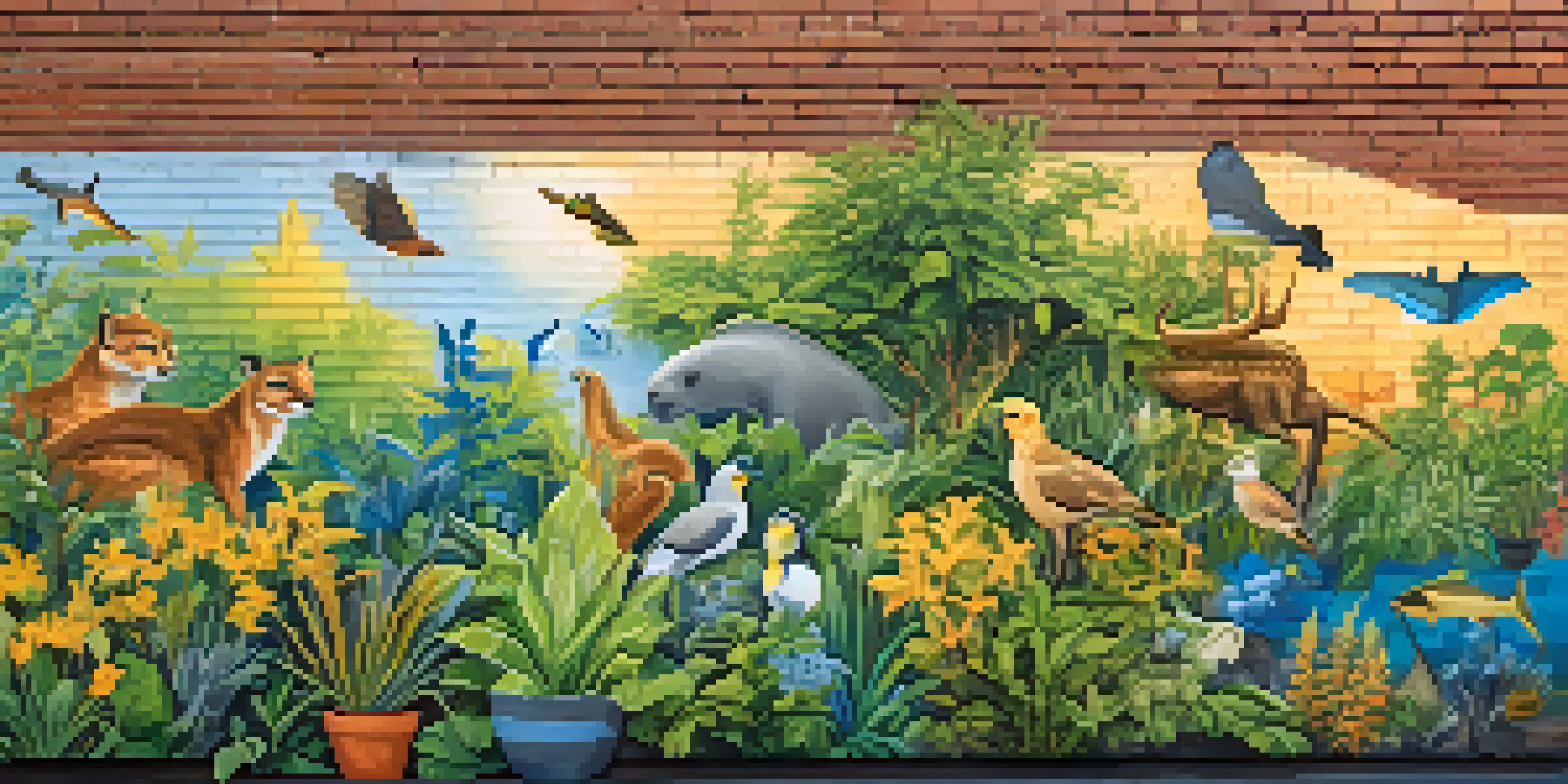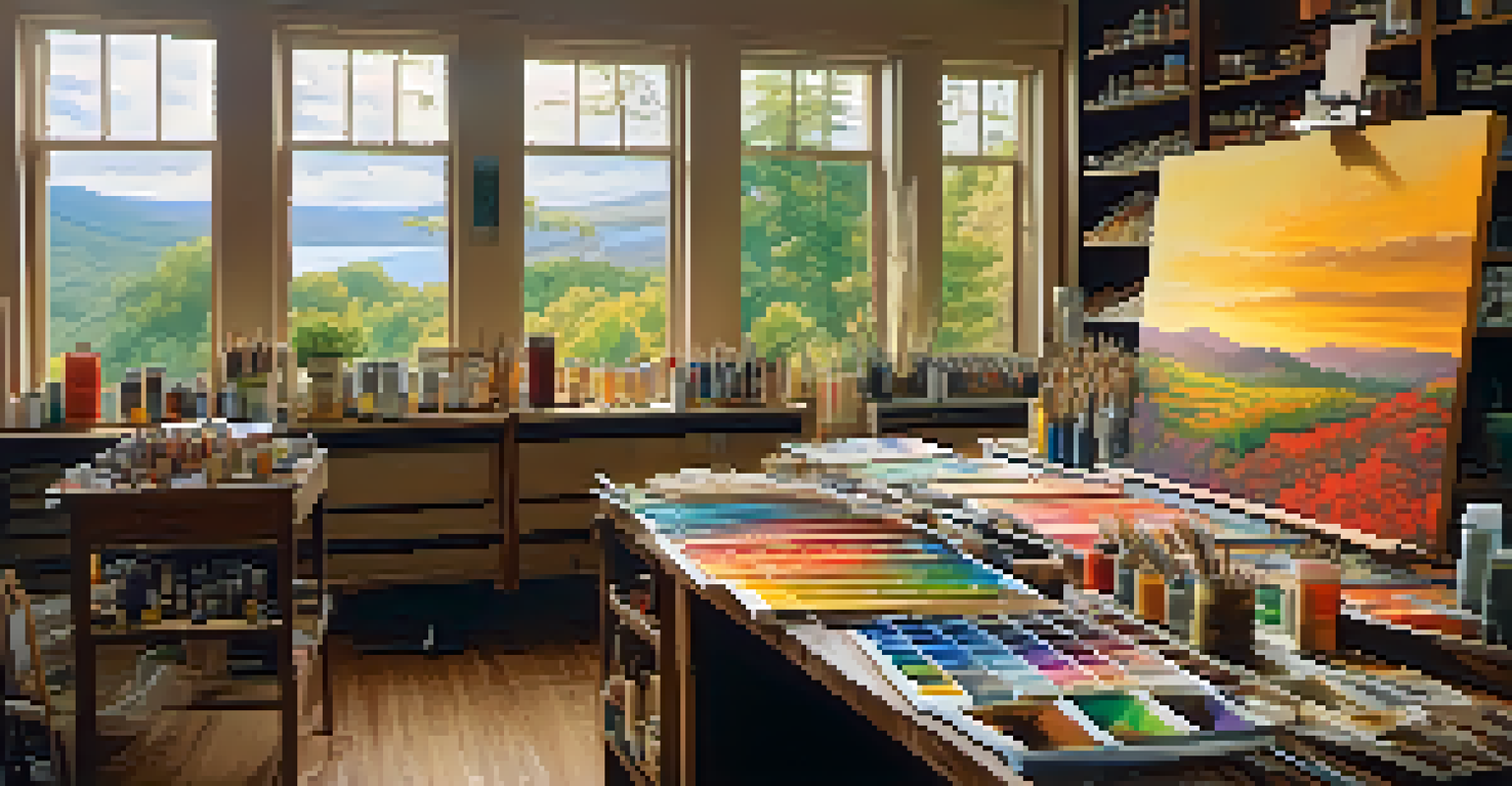Artistic Expressions: Painting as a Medium for Sustainability

The Role of Art in Environmental Advocacy
Art has always been a powerful tool for communication, and when it comes to environmental issues, painting serves as a compelling medium. Artists can convey complex ideas about sustainability in ways that resonate with people, often sparking conversations that lead to action. Through vivid imagery and emotional storytelling, paintings can highlight the beauty of nature and the urgent need for its preservation.
Art is the most beautiful of all lies; it is a form of communication that transcends barriers and speaks to the heart of humanity.
Consider the iconic works of artists like Claude Monet, whose landscapes remind us of the fragility of our ecosystems. By showcasing the splendor of the natural world, they evoke a sense of responsibility towards its protection. This emotional connection can be a catalyst for change, prompting viewers to reflect on their own environmental impact.
Moreover, public art installations focused on sustainability can engage communities and foster a collective commitment to environmental stewardship. When art becomes a part of the community dialogue, it can influence attitudes and behaviors, making sustainability a shared goal.
Eco-Friendly Materials and Techniques in Painting
As the art world evolves, many artists are turning to eco-friendly materials to minimize their environmental footprint. Using non-toxic paints, recycled canvases, and sustainable brushes, they create works that not only look good but also align with their values. This shift towards green materials reflects a growing awareness of the environmental impact of traditional art supplies.

For instance, some artists are experimenting with natural pigments made from plants or minerals, which are not only safer for the environment but also offer unique colors and textures. These choices encourage creativity while supporting a more sustainable art practice. By opting for materials that are biodegradable or sourced ethically, artists can contribute to a healthier planet.
Art Sparks Environmental Action
Through emotional storytelling and impactful imagery, art can inspire individuals to reflect on their environmental responsibilities and take action.
Additionally, the techniques used in creating art can also be modified to promote sustainability. Whether it’s through water-saving methods or energy-efficient studio practices, every little change counts, inspiring other artists to adopt similar practices.
Art as a Catalyst for Environmental Education
Painting can serve as an educational tool, helping to raise awareness about environmental issues. Many artists use their work to illustrate the impacts of climate change, pollution, and deforestation, making these abstract concepts more tangible. By depicting the consequences of these challenges, they invite viewers to engage with the topic on a personal level.
The greatest threat to our planet is the belief that someone else will save it.
Art exhibits that focus on environmental themes often include informative sessions or workshops, providing audiences with the knowledge they need to make informed decisions. This combination of visual appeal and educational content can inspire visitors to take action, whether that means reducing waste or advocating for policy changes.
Moreover, schools and community programs that incorporate painting into their curricula can foster a deeper understanding of sustainability among young people. By engaging students through art, we can nurture a generation that values and prioritizes environmental responsibility.
Community Engagement through Collaborative Art Projects
Collaborative art projects can unite communities around sustainability goals, fostering a sense of shared purpose. When individuals come together to create a mural or a series of paintings, they not only express their views but also build connections with one another. This communal approach can spark discussions about local environmental issues and inspire collective action.
For example, community murals depicting local flora and fauna can raise awareness about the importance of biodiversity while beautifying public spaces. These projects often involve workshops that educate participants about the environmental themes being portrayed, making the process both informative and enjoyable.
Sustainable Practices in Art
Artists are increasingly adopting eco-friendly materials and techniques, contributing to a more sustainable art practice that aligns with environmental values.
Involving local artists and residents in these projects ensures that the artwork reflects the community's unique relationship with the environment. Such engagement can lead to a stronger commitment to sustainability at the grassroots level.
The Impact of Digital Art on Sustainability Awareness
In today’s digital age, artists are harnessing technology to spread their sustainability messages far and wide. Digital paintings, animations, and interactive art can reach audiences globally, transcending geographical barriers. This accessibility allows for a broader conversation about environmental issues, engaging diverse perspectives.
For instance, social media platforms have become a gallery for artists to share their work with a wider audience, often sparking viral movements around sustainability. Digital art can also be easily shared, making it a powerful tool for advocacy and awareness campaigns.
Additionally, some artists are exploring virtual reality (VR) as a medium, allowing viewers to immerse themselves in experiences that highlight environmental challenges. By creating engaging and interactive content, they can cultivate empathy and a deeper understanding of the issues at hand.
Art Exhibitions Focused on Sustainability
Art exhibitions centered on sustainability provide a platform for artists to showcase their works while addressing urgent environmental concerns. These events not only highlight the importance of art in advocating for the planet but also bring together like-minded individuals who are passionate about making a difference. By curating exhibitions that focus on ecological themes, galleries can contribute to the ongoing dialogue about sustainability.
For instance, exhibitions featuring artists who use recycled materials challenge the notion of waste in art. By transforming discarded items into beautiful pieces, they inspire viewers to rethink their consumption habits and consider the lifecycle of materials.
Community Engagement through Art
Collaborative art projects unite communities around sustainability goals, fostering connections and raising awareness about local environmental issues.
Moreover, these exhibitions often include discussions, panels, and workshops that delve deeper into the intersection of art and sustainability. By fostering a space for dialogue, they empower attendees to explore how they can incorporate sustainable practices into their own lives.
The Future of Painting and Sustainability
As we look to the future, the relationship between painting and sustainability is bound to evolve. Artists will continue to experiment with innovative materials and techniques that reflect a growing commitment to environmental consciousness. The art world is increasingly recognizing its role in the broader conversation about sustainability, and this trend is likely to gain momentum.
Emerging technologies, such as augmented reality (AR), may also play a role in how artists convey their messages. Imagine walking through a gallery where the paintings come to life, illustrating the environmental issues they depict in real-time. This merging of art and technology could further engage audiences and foster a greater understanding of sustainability.

Ultimately, the future of painting as a medium for sustainability lies in collaboration—between artists, communities, and environmental organizations. By working together, we can harness the transformative power of art to inspire change and create a more sustainable world.